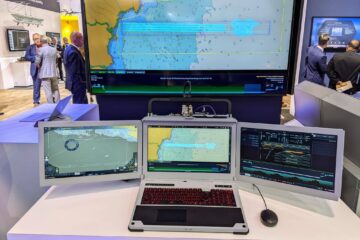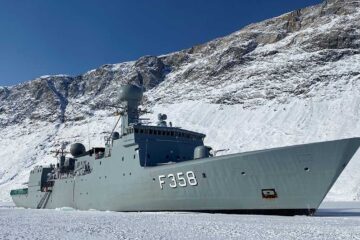Admiral de Beurme discussed with Naval News the challenges posed by the fact these two major programs are being run at the same time, he gave us an update on the MCM replacement program, outlined the expected economic impact from this program and explained how the Belgian Navy will remain a reference worldwide in the field of mine warfare.
The Admiral then gave us an update on the ASWF program, and told us how Belgium is looking at fitting the future frigates with ballistic missile defense (BMD) capability.
Last but not least, Admiral de Beurme gave us some details about the PESCO MAS MCM project and how it ties in with the MCM program.

Naval News – The Belgian Navy currently has two major programs going, the MCM replacement and the frigate replacement. These two programs will shape the future of the Marine Component for years to come. How challenging is it?
Admiral de Beurme – In June 2018 the Belgian and Dutch Minister of Defense signed the MoU for the M-frigate and MCM replacements projects. The Netherlands is in the lead (“lead nation'”) for the frigate program: 2 ships will be built for each country. Belgium is in charge for the MCM program: Twelve vessels in total: 6 for the Dutch Navy, 6 for the Belgian Navy. Both programs for a budget of around 2 billion euros. The frigate replacement program consists of the building of 4 new multipurpose-frigates specialized in Antisubmarine Warfare, as stated above: two for the Netherlands, two for Belgium. Both replacement programs use new technologies, which need a new way of planning and operating. The projects are very challenging, not only for my staff, but also for the industries, as we deal with rapidly evolving technologies. The future capacities
are more and more based on unmanned systems. For example, a rotary wing UAV will be used for the extension of the surveillance capacity of the frigates. In the mine warfare domain drones will be used in the three dimensions (air, sea, underwater). The program are very innovative and will be based on new concepts of deployment.
Naval News – Regarding rMCM, what is the current status? Are you pleased with the progress so far?
Admiral de Beurme – The Preliminary Design Review was, despite the current COVID-19 situation, successfully completed at the end of 2020. Since all reviews were conducted in close cooperation with the operational user, we are convinced that the ships and the tools will meet all the requirements needed to perform the mission in a safe and efficient way. Furthermore, the contractor is also eager to deliver an optimal solution for this innovative and (r)evolutionary program to be the first one to deliver a fully integrated stand-off MCM capability. This is a win-win situation and the contractor answers constructively to all remarks and questions of our binational program office. So, we look forward to the keel laying of the first ship scheduled at the end of this year.
Naval News – Will the program bring a positive economic impact here in Belgium?
Admiral de Beurme – Yes. The contractual requirements in regards to the essential security interests generates a positive economic return on investment for Belgium. The return is generated in different domains.
- Firstly, several systems for the MCM motherships, such as engines from ABC, the remotely operated weapons systems from purchased in Belgium.
- Secondly, ECA Robotics Belgium is currently building the drone factory in Ostend (Belgium) where all the unmanned systems for the rMCM program will be built. Furthermore, ECA Robotics Belgium will also be the prime manufacturer for all unmanned systems for ECA Group destined for export. This manufacturing plant will generate 70 jobs.
- Thirdly, expertise centers for Mine countermeasures and Cybersecurity are in development through a triple helix approach, thus involving Belgian industry.
- Finally, several partnerships between BNR (Belgian Naval & Robotics} and Belgian stakeholders are planned in the domain of R&D.
Globally, all these measures could generate a huge economic return between 2019 and 2039
Naval News – The Belgian Navy will be among the first in the world to adopt the “sailor outside of the minefield” concept through the use of unmanned systems. How will you make sure that your navy remains a reference within NATO navies in the field of mine warfare?
Admiral de Beurme – The future MCM concept is indeed one of standoff. The current minehunters are still navigating inside the minefield, the new vessels will remain outside and will serve as mother platform for the unmanned vehicles. The tools and the toolbox will operate at distance (10 up to 20 nautical miles). Industries are embracing this new concept. Today industries are really focusing on the unmanned systems and technologies, and do not invest anymore in further development of the classical hull mounted sonar. With this new concept and capacity, we want to correct the recognized shortfalls of the current minehunter. In EGUERMIN, Ostend. a new simulator will be installed and a MCM lab will be build. The facilities in Ostend will remain a centre of excellence for modern MCM concept and operations.

Naval News – Can you please give us an update regarding the ASWF program ?
Admiral de Beurme – The binational Anti-Submarine Warfare frigates (ASWF) project completed phase B last year with a selected concept design for the ASW frigate . The project is now in the detailed design phase (DMP-D phase) and currently in the procurement preparation phase for a request for quotation from suppliers.
Naval News – The Belgian MoD recently stated that the Belgian Navy could play a role in Ballistic Missile Defense. Can you shed light on this?
Admiral de Beurme – According to the Strategic Vision 16, Belgium is investigating the possibility to develop a Maritime capability o f Ballistic Missile Defense. There is no specific changes currently. The Strategic Vision will be reviewed by the Strategic review working group.
Naval News – Belgium is leading the PESCO MAS MCM project. What is this project about?
Admiral de Beurme – The Maritime (semi-) Autonomous Systems for Mine Countermeasures (MAS MCM) will deliver a world-class mix of (semi-) autonomous underwater, surface and aerial technologies for maritime mine countermeasures. The project will enable Member States to protect maritime vessels, harbors and off shore installations, and to safeguard freedom of navigation on maritime trading routes. The development of autonomous vehicles, using cutting-edge technology and an open architecture, adopting a modular set up, will contribute significantly to the EU’s maritime security by helping to counter the threat of sea mines. The aim of this project is to develop the future toolbox (autonomous vehicles) to counter the mines threat.





